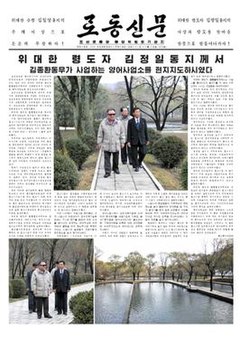|
Rodong Sinmun
 Rodong Sinmun (IPA: [ɾo.doŋ ɕin.mun]; Korean: 로동신문; lit. labor news) is a North Korean newspaper that serves as the official newspaper of the Central Committee of the Workers' Party of Korea. It was first published on 1 November 1945, as Chŏngro (Korean: 정로; Hancha: 正路; lit. correct path), serving as a communication channel for the North Korea Bureau of the Communist Party of Korea; it was renamed in September 1946. Quoted frequently by the Korean Central News Agency (KCNA) and international media, it is regarded as a source of official North Korean viewpoints on many issues. An English-language version of Rodong Sinmun was launched in January 2012.[2] The editor-in-chief is Kim Pyong-ho.[3] A list of articles published in Rodong Sinmun since 1946 is available online on the websites of the Information Center on North Korea (unibook.unikorea.go.kr) and the North Korea information portal (nkinfo.unikorea.go.kr).[4] Due the low wages paid by the newspaper, many journalists have had to use the privilege of being able to travel freely in the country to collect bribes or engage in underground trade in order to make a living.[5] ContentsRodong Sinmun is published every day of the year and usually contains six pages.[6] The newspaper has approximately 100 reporters.[citation needed] Following the purge and execution of Jang Song-thaek, Rodong Sinmun deleted some 20,000 articles from its web archives,[7] while others were edited to omit his name.[8] Rodong Sinmun content can be accessed over the Mirae WiFi network in North Korea.[9] New Year editorials
Since 1996, Rodong Sinmun, the Korean Central News Agency, Minju Joson, and Joson Inmingun has published a joint New Year editorial that outlines the country's policies for the year.[10][11] The editorials usually offer praise for the Songun policy, the government and leadership, and encourage the growth of the nation. They are also critical of the policies of South Korea, Japan, the United States, Israel and Western governments towards North Korea and/or its allies.[12][13][14] On 1 January 2006, the agency sent out a joint-editorial from North Korea's state newspapers calling for the withdrawal of American forces from South Korea.[10] While annual 1 January editorials are a tradition among the papers, that year's brought attention from Western media outlets, by calling for a "nationwide campaign for driving out the U.S. troops".[15] The editorial made several references to Korean reunification. The 2009 editorial received similar attention, as criticism of United States policy was absent, and the admission of severe economic problems in North Korea. The editorial also made reference to denuclearisation on the Korean Peninsula, in what analysts claimed was a "hopeful" sign.[16][17] This was echoed again in its 2010 editorial, which called for an end to hostilities with the United States and a nuclear free Korean Peninsula.[18] The 2011 joint editorial edition,[11] aside from its calls for a denuclearized Korea and for a slowdown of tensions between the two Koreas, has for the first time, mentioned the rising light industries of North Korea, given as a reason for an upcoming upsurge in the national economy in the new year and for the achievement of the Kangsong Taeguk national mission. The practice of a joint New Year editorial ended in 2013 when Kim Jong Un delivered the first New Year speech on television in 19 years.[19] In June 2018, Rodong Sinmun devoted a four-page feature to the North Korea–United States summit, welcoming its results. The article carried the text of the declaration in full. In addition, it mentioned security guarantees and Donald Trump's pledge to cease the joint military exercises with South Korea, and failed to mention the promise Kim had allegedly made to Trump about closing down a test site for missile engines.[20] See also
References
External linksWikimedia Commons has media related to Rodong Sinmun. |
||||||||||||||||||||||||||||||||||||||||
Portal di Ensiklopedia Dunia

